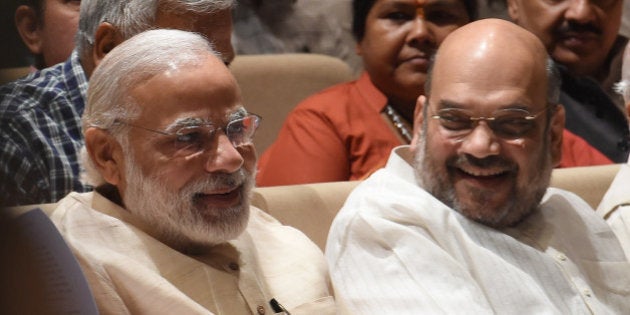
Seldom has a party president been entrusted with a task that prime ministers traditionally perform themselves. By leaving it to Amit Shah this time to convey the good news to aspiring ministers, Narendra Modi has sent out two strong messages.
One, that Shah has acquired a pivotal role in the current dispensation with a brief that is nudging its way beyond the party organization to matters of state. While Modi may have had the final say in the choice of new entrants into his council of ministers, it was Shah who picked them out for the PM's approval.
More importantly, Modi stayed out of the picture and anointed Shah as his proxy to deliver the coveted invitation to join the government. Two, politics and electoral calculations, not governance and performance, are the drivers for the current expansion exercise. All the 19 newcomers have been chosen keeping in mind caste, community and region and looking ahead at not just the upcoming state polls in 2017 and 2018, but the big national election in 2019.
Five Dalits, two tribals, a host of OBCs, a Muslim, a Sikh, a Brahmin from UP (where elections are due in Feb/March 2017), two Patels from the Patidar community which is on warpath in Gujarat (which goes to polls in November 2017) and a Bania from Delhi (Vijay Goel, presumably to counter chief minister Arvind Kejriwal) are among the 19 new inductees who represent ten states.
There are no doubts about the rise and rise of Amit Shah in Modi raj.
At one level, this is good old fashioned Congress-style political jugglery, of doling out something for every section so that no-one is unhappy. At the same time, it is very much in line with the BJP's new aggressive outreach to social groups and communities that were never part of its core voter base.
All the 19 newcomers have been chosen keeping in mind caste, community and region.
Shah has been pursuing this path relentlessly, dining with Dalits, promoting OBCs in the party hierarchy and hunting for allies who represent communities that were once the vote banks of the Congress but gradually drifted away to regional parties.
Modi's 2014 electoral success was built on Shah's ability to woo some of these sections, particularly in UP and Bihar. But with less than three years to go for the 2019 polls, it has become imperative to consolidate on the gains of 2014 for the future. It is questionable whether caste and community calculations in a cabinet exercise yield electoral dividends. In UP, the battle lines seem to be firming up between the two regional behemoths, the SP and BSP.
The BJP and the Congress are still debating whether or not to project a chief ministerial face and who or which caste to promote. And in Gujarat, the Patels, who have been the backbone of the BJP's dominance in the state, seem to be in an unforgiving mood. There are no doubts, however, about the rise and rise of Amit Shah in Modi raj.

Experienced political watchers were bemused to see the procession of would-be ministers streaming into Shah's Akbar Road residence to receive the invitation every politician would give an arm and a leg for. Both at the time of government formation in May 2014 and his first cabinet expansion in November the same year, Modi had called his would-be ministerial colleagues one by one to give them the good news.
It has always been the norm for the PM to conduct this exercise. Atal Bihari Vajpayee and his deputy LK Advani used to do it jointly. It was the same in the UPA tenure when Manmohan Singh and Sonia Gandhi would meet new ministers together.
Everyone knew that Sonia was the final authority even for the choice of members of Manmohan's ministerial council but they observed the tradition of the PM's privilege.
Modi has bypassed convention by handing over this privilege to Amit Shah this time. In the process, he has exalted Shah's status and created room for speculation that the Modi-Shah-Jaitley triumvirate may be a thing of past. A duopoly seems to be in the making.
The twin messages from the expansion exercise are an indication that after two years of feeling his way around Delhi's murky power corridors, Modi has decided that it's time for political consolidation. Well-wishers of his government may lament that merit has been sacrificed at the altar of political compulsions. But when there are important elections to win, politics will always trump good governance.



Contact HuffPost India
Also see on HuffPost: